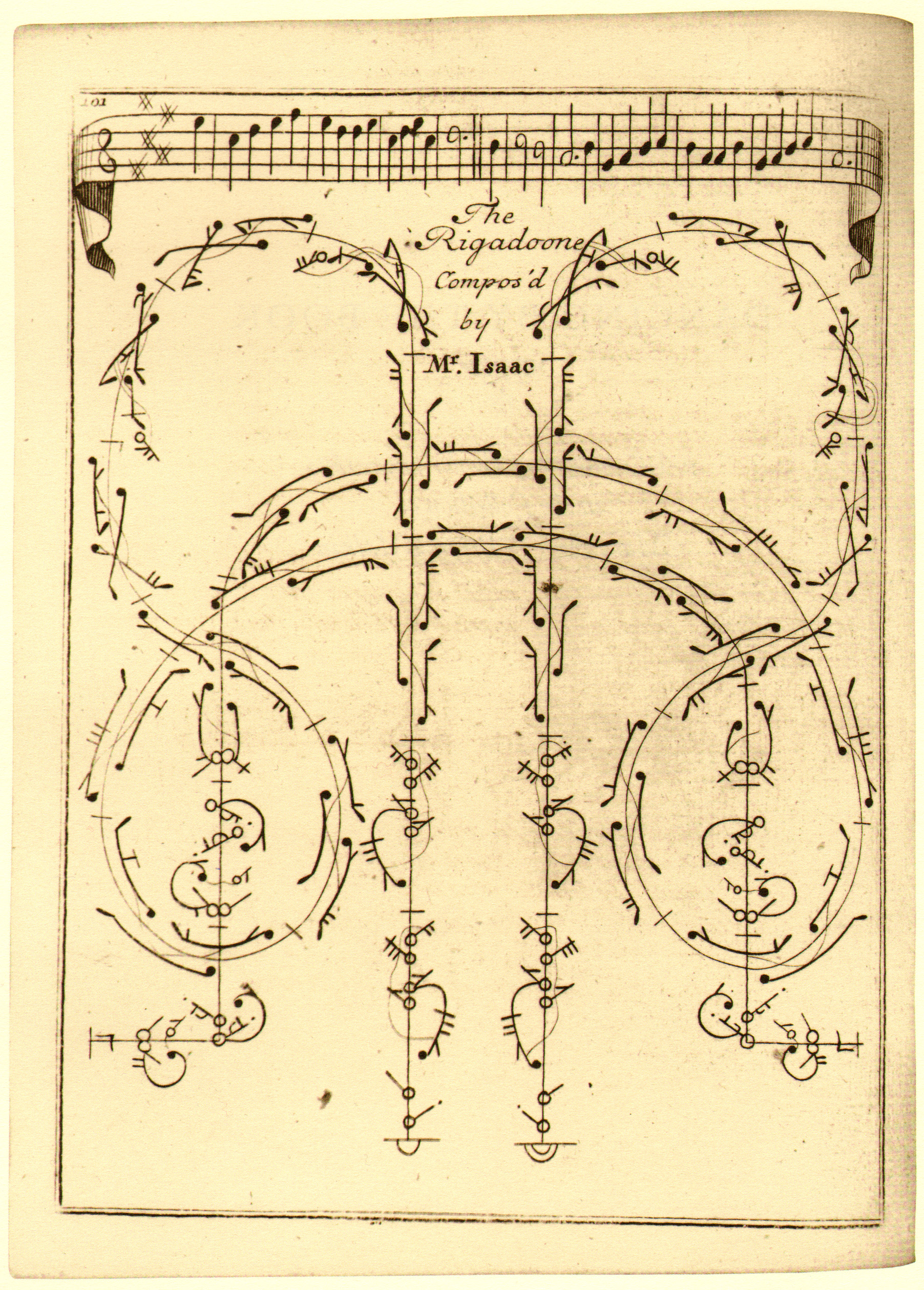Rigaudon on:
[Wikipedia]
[Google]
[Amazon]
 The rigaudon (, ), anglicized as rigadon or rigadoon, is a French
The rigaudon (, ), anglicized as rigadon or rigadoon, is a French
 The rigaudon (, ), anglicized as rigadon or rigadoon, is a French
The rigaudon (, ), anglicized as rigadon or rigadoon, is a French baroque dance
Baroque dance is dance of the Baroque era (roughly 1600–1750), closely linked with Baroque music, theatre, and opera.
English country dance
The majority of surviving choreographies from the period are English country dances, such as those in ...
with a lively duple metre
Duple metre (or Am. duple meter, also known as duple time) is a musical metre characterized by a ''primary'' division of 2 beats to the bar, usually indicated by 2 and multiples (simple) or 6 and multiples ( compound) in the upper figure of the ti ...
. The music is similar to that of a bourrée
The bourrée (; ; also in England, borry or bore) is a dance of French origin and the words and music that accompany it. The bourrée resembles the gavotte in that it is in Duple and quadruple meter, double time and often has a dactyl (poetry), ...
, but the rigaudon is rhythmically simpler with regular phrases (eight measure phrases are most common). It originated as a sprightly 17th-century French folk dance for couples. Traditionally, the folkdance was associated with the provinces of Vivarais
Vivarais (; ; {{cite web , url=http://www.columbia.edu/acis/ets/Graesse/orblatv.html , title = ORBIS LATINUS - Letter V) is a traditional region in the south-east of France, covering the ''département'' of Ardèche, named after its capital Vivier ...
, Languedoc
The Province of Languedoc (, , ; ) is a former province of France.
Most of its territory is now contained in the modern-day region of Occitanie in Southern France. Its capital city was Toulouse. It had an area of approximately .
History
...
, Dauphiné
The Dauphiné ( , , ; or ; or ), formerly known in English as Dauphiny, is a former province in southeastern France, whose area roughly corresponded to that of the present departments of Isère, Drôme and Hautes-Alpes. The Dauphiné was ...
, and Provence
Provence is a geographical region and historical province of southeastern France, which stretches from the left bank of the lower Rhône to the west to the France–Italy border, Italian border to the east; it is bordered by the Mediterrane ...
in southern France, and it became popular as a court dance during the reign of Louis XIV
LouisXIV (Louis-Dieudonné; 5 September 16381 September 1715), also known as Louis the Great () or the Sun King (), was King of France from 1643 until his death in 1715. His verified reign of 72 years and 110 days is the List of longest-reign ...
. Its hopping steps were adopted by the skillful dancers of the French and English courts, where it remained fashionable through the 18th century. By the close of the 18th century, however, it had given way in popularity as a ballroom dance (along with the passepied
The passepied (, "pass-foot", from a characteristic dance step) is a French court dance. Originating as a kind of Breton branle, it was adapted to courtly use in the 16th century and is found frequently in 18th-century French opera and balle ...
, bourrée
The bourrée (; ; also in England, borry or bore) is a dance of French origin and the words and music that accompany it. The bourrée resembles the gavotte in that it is in Duple and quadruple meter, double time and often has a dactyl (poetry), ...
, and gigue
The gigue ( , ) or giga () is a lively baroque dance originating from the English jig. It was imported into France in the mid-17th centuryBellingham, Jane"gigue."''The Oxford Companion to Music''. Ed. Alison Latham. Oxford Music Online. 6 July ...
) to the minuet
A minuet (; also spelled menuet) is a social dance of French origin for two people, usually written in time. The English word was adapted from the Italian ''minuetto'' and the French ''menuet''.
The term also describes the musical form tha ...
; however, in the 20th century, Maurice Ravel
Joseph Maurice Ravel (7 March 1875 – 28 December 1937) was a French composer, pianist and conductor. He is often associated with Impressionism in music, Impressionism along with his elder contemporary Claude Debussy, although both composer ...
would employ this baroque dance in his piano suite ''Le Tombeau de Couperin
''Le Tombeau de Couperin'' (''The Tomb of Couperin'') is a suite (music), suite for solo piano by Maurice Ravel, composed between 1914 and 1917. The piece is in six movements, based on those of a traditional Baroque music, Baroque suite. Each ...
''.
Sources
Further reading
* * * * * Baroque dance French dances Dance forms in classical music {{Europe-dance-stub